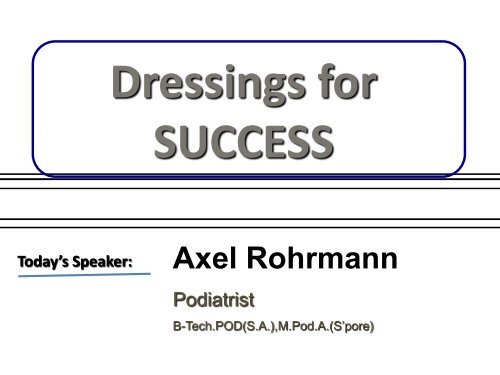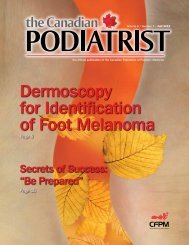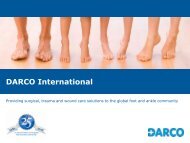Dressings for Success
Dressings for Success
Dressings for Success
Create successful ePaper yourself
Turn your PDF publications into a flip-book with our unique Google optimized e-Paper software.
<strong>Dressings</strong> <strong>for</strong><br />
SUCCESS<br />
Today’s Speaker:<br />
Axel Rohrmann<br />
Podiatrist<br />
B-Tech.POD(S.A.),M.Pod.A.(S’pore)
TALK OUTLINE<br />
What is wound care<br />
10 minutes<br />
Classifications<br />
Treatment options<br />
10 minutes<br />
10 minutes<br />
Case studies and discussion<br />
5 minutes
What does wound care mean to you?<br />
• My patient X ….<br />
• Return to normalcy, routine activities of daily<br />
living.<br />
• Improved quality of life.<br />
• Long term success.
<strong>Dressings</strong> <strong>for</strong> success!<br />
• Understanding the basic principles of wound<br />
management and coupling that with<br />
knowledge of the dressing characteristics can<br />
help to make the decision-making process<br />
easier.
A wound dressing is a substitute <strong>for</strong><br />
native epithelium<br />
• The process of wound repair occurs in stages each of which<br />
will require different dressings.<br />
• <strong>Dressings</strong> provide the optimum environment <strong>for</strong> rapid healing<br />
by protecting the wound from further:<br />
– trauma,<br />
– bacterial invasion or<br />
– exposure to caustic substances,<br />
• Be able to:<br />
– con<strong>for</strong>m to the wound shape,<br />
– absorb wound fluid,<br />
– provide pressure <strong>for</strong> hemostasis<br />
– should also support the wound and surrounding tissues,<br />
– eliminate pain,<br />
– easily applied and removed with minimal injury to the wound.
Not all wounds are the same!<br />
• Neuropathic, arterial, venous, chronic, acute,<br />
mixed, gout,<br />
• Clean, granulating, epitheliizing, remodeling,<br />
• Healing, stalled, non-healing.<br />
• Wound Aetiologies differ from wound to<br />
wound!
Wound dressing categories<br />
- Alphabet soup -<br />
• Absorptive Dressing<br />
• Alginates<br />
• Antimicrobials<br />
• Cleansers<br />
• Closure Devices<br />
• Collagen<br />
• Compression Dressing & Wraps (Leg)<br />
• Composite Dressing<br />
• Contact Layer<br />
• Enzymatic Debriders<br />
• Fillers (wound)<br />
• Foam <strong>Dressings</strong><br />
• Growth Factors<br />
• Hydrocolloid<br />
• Hydrofiber<br />
• Hydrogel<br />
• Hydrogel Impregnated Gauze<br />
• Hydrogel Sheet<br />
• Miscellaneous Devices<br />
• Negative Pressure Wound Therapy<br />
(NPWT)<br />
• Odor Absorbing<br />
• Scar Therapy<br />
• Skin Care<br />
• Skin Substitutes<br />
• Tissue Engineering / Growth Factors<br />
• Transparent Films
•Wound healing phase
Progression of Acute wound healing
Chronic wounds can get stalled.
FACTORS AFFECTING WOUND HEALING<br />
• PVD<br />
• Infection<br />
•Trauma<br />
• Presence<br />
of necrosis<br />
or slough<br />
• Age<br />
• Poor<br />
Nutrition<br />
•Poor wound care<br />
•Drugs<br />
•Other systemic<br />
diseases:<br />
• DM<br />
• Anaemia
FACTORS DELAYING WOUND HEALING<br />
• Bio-film<br />
•Damaged matrix<br />
•Growth factors<br />
receptors/deficiency<br />
•Infection<br />
•High proteases<br />
•Inflammatory environment<br />
•Non migratory cells<br />
•Senescent cells<br />
•Hyper proliferative edge<br />
epithelium<br />
CAN WE MODULATE THESE EVENTS?
• <strong>Dressings</strong> will create an environment<br />
that may facilitate healing<br />
• If underlying causes are not treated<br />
then the wound is unlikely to heal.<br />
• Remember there is no miracle dressing<br />
that will heal all wounds!!!
Properties of an ideal dressing<br />
• Bacteria proof<br />
• Allows gaseous exchange<br />
• Manages exudate<br />
• Non-adherent<br />
• Fibre and toxin free<br />
• Hypoallergenic<br />
• Maintain haemostasis and optimum<br />
temperature.<br />
• Acceptability to patient<br />
• Cost effective.
Choosing the right dressing!<br />
• Thorough patient & wound assessment.<br />
• Don’t make the wound fit the dressing.<br />
• Consider the wound and patients needs.<br />
– Dressing frequency, home care, compression, TCC<br />
• Size of the wound – cost effectiveness<br />
– NPWT till wound is smaller<br />
• Exudate<br />
• Surrounding skin – peri wound protection<br />
• Bioburden – threat of contamination at changes<br />
• Pain at dressing changes
Tissue type in the wound<br />
• Necrotic – debride<br />
• Epitheliizing – protect<br />
Granulating – maintain<br />
Remodeling - assist
he commonly used dressing categories<br />
• Excluding gauze and other cotton packing<br />
materials,<br />
• Include transparent film dressings,<br />
hydrocolloids, hydrogels (amorphous and<br />
sheet), calcium alginates and foams, and will<br />
be discussed
Transparent film dressings<br />
• Semi permeable adhesive polyurethane<br />
• Can cause maceration as non absorbent<br />
• Vapour permeable.<br />
• Can be left <strong>for</strong> upto 7 days<br />
• Waterproof protection<br />
• Can be used as primary and secondary dressing<br />
• Remove by lifting corner and stretching<br />
horizontally.
Hydrocolloid dressings<br />
• Composed of pectin, carboxymethylcellulose<br />
and adhesives.<br />
• Gel is <strong>for</strong>med at the wound interface<br />
• Indicated <strong>for</strong> wounds that are low-tomoderately<br />
exuding.<br />
• Not recommended <strong>for</strong> use on infected wounds<br />
• can be left in place up to seven days
Hydrogels<br />
• Moisture-donating materials composed of polymers<br />
• Have additional water or glycerin <strong>for</strong> moisture<br />
• Hypertonic sodium <strong>for</strong> enhanced fluid shift to aid in<br />
autolytic debridement<br />
• Ability to hydrate a dry wound surface fairly rapidly<br />
• Promotes debridement of eschar and slough.<br />
• Hydrogel sheets may reduce pain.<br />
• Caution if used on infected wounds.<br />
• Requires secondary dressing
Calcium alginates<br />
• Non-woven fibres derived from brown seaweed<br />
• Have a haemostatic effect – release of Ca ions<br />
• Contact with sodium-rich fluid, such as wound<br />
exudate, creating sodium alginate gel<br />
• Changed according to the level of exudate.<br />
• Highly absorbent and biodegradable can absorb<br />
20 times own weight. Made from brown<br />
seaweed.<br />
• Suitable <strong>for</strong> wet or cavity wounds.
Hydrofibers®<br />
• Sodium carboxymethylcellulose fibres absorb<br />
moderate-to-large amounts of wound exudate<br />
• Absorbs wound fluid and trans<strong>for</strong>ms into soft gel.<br />
• Highly absorbent<br />
• Promotes debridement.<br />
• Absorbs and locks in bacteria and exudate<br />
• Decrease in fluid can cause the dressings to dry<br />
out and become painfully adherent
Foams<br />
• polyurethane with or without a film outer<br />
layer to prevent 'strike-through'<br />
• differences between the various foam<br />
dressings, including thickness and the ability<br />
to donate rather than absorb moisture<br />
• may be used in most wound types<br />
• frequency of change will be dependent upon<br />
the primary dressing<br />
• Can be use as primary or secondary dressing
Wound contact layers<br />
• Non adherent dressings <strong>for</strong> lightly<br />
exuding granulating wounds<br />
• Prevents trauma to wound bed.
Antimicrobials
Inadine and cadexomer iodine<br />
Inadine –10%<br />
povidone-iodine<br />
Cadexamor iodine –<br />
released from starch<br />
when in contact with<br />
wound exudate<br />
Caution in thyroid<br />
patients iodine<br />
sensitivity, renal<br />
problems
Silver<br />
Aqucel AG -1.2%<br />
Acticoat – nano<br />
crystalline silver –<br />
rapid bacteria kill due<br />
to high concetration of<br />
elemental silver<br />
Actisorb silver – with<br />
charcoal <strong>for</strong> odour
PHMB (Polyhexamethylene<br />
•Wound cleanser-<br />
Surfactant<br />
•Debriding hydro gel<br />
•Contains betadine<br />
which penetrates and<br />
removes bacteria<br />
biguanide)
Honey<br />
Algivon<br />
Non –adherent alginate<br />
impregnated with medical<br />
grade Manuka honey<br />
•Facilitates debridement<br />
•Inhibits bacterial growth<br />
•Reduces odour.
Photo courtesy of Dr. Axel Rohrmann, Podiatrist.<br />
Case studies
•Diagnose cause<br />
•Good wound care<br />
•Appropriate pressure<br />
relief<br />
Photo courtesy of Dr. Axel Rohrmann, Podiatrist.<br />
PRESSURE ULCER
Photo courtesy of Dr. Axel Rohrmann, Podiatrist.
Photo courtesy of Dr. Axel Rohrmann, Podiatrist.
Photo courtesy of Dr. Axel Rohrmann, Podiatrist.
Conclusion<br />
• There is no miracle dressing that will<br />
heal a wound if underlying aetiologies<br />
are not addressed.<br />
• It is important that you understand the<br />
properties of different dressings and<br />
their function.<br />
• If you think that a dressing is not<br />
meeting the needs of the patient you<br />
must ensure that a qualified member<br />
of staff reassess the wound ASAP!
• Find a way to have fun<br />
Photo courtesy of Dr. Axel Rohrmann, Podiatrist.<br />
Photo courtesy of Dr. Axel Rohrmann, Podiatrist.
Thank you<br />
axelrohrmann@gmail<br />
Tel.: 306)522 3346 Fax.: 306) 522 3348<br />
Copyright<br />
2013. Dr. Axel Rohrmann. All rights reserved
List of products & manufacturer.<br />
• Please not this list is not exhaustive and<br />
manufactures may choose to add, remove or<br />
rename products periodically.<br />
• All categories are not included in this list.<br />
• Please check <strong>for</strong> dressing products available in<br />
your health region, province or country.
Absorptive dressing<br />
• Product<br />
Manufacturer<br />
• Medipore 3M<br />
• Aquacel Hydrofiber<br />
• CombiDERM ConvaTec<br />
• Absorptive Border DermaRite<br />
• IODOFLEX HEALTHPOINT<br />
• TIELLE Johnson & Johnson<br />
• CURITY ABD<br />
• TELFAMAX<br />
• TENDERSORB ABD Kendall<br />
• Mepore Molnlycke Health Care<br />
• EXU-DRY<br />
• Primapore Smith & Nephew
Alginates<br />
• Product<br />
Manufacturer<br />
• AlgiSite M<br />
Smith & Nephew, Inc. Wound<br />
• Hyperion Advanced Alginate Hyperion Medical, Inc.<br />
• KALTOSTAT<br />
ConvaTec<br />
• Melgisorb<br />
Molnlycke Health Care<br />
• PolyMem<br />
Ferris Mfg.<br />
• Restore CalciCare Hollister<br />
• SILVERCELL<br />
Johnson & Johnson<br />
• Sorbalgon<br />
Harmann-Conco Inc.<br />
• SeaSorb<br />
Coloplast Corp.<br />
• Tegagen HG<br />
• Tegagen HI<br />
3M Health Care
Antimicrobial dressings<br />
• Product Manufacturer<br />
• 3M Tegaderm Ag Mesh 3M<br />
• Amerigel Amerx Health Care Corp.<br />
• Contreet Coloplast Corp.<br />
• Collatamp G Theramed<br />
• Aquacel Ag ConvaTec<br />
• Hydrofera Blue Hydrofera Inc.<br />
• Actisorb Johnson & Johnson<br />
• Kerlix AMD<br />
• Curity AMD<br />
• Excilon AMD<br />
• TELFA AMD Kendall / Tyco<br />
• Acticoat 3<br />
• Acticoat 7<br />
• Acticoat Moisture Control<br />
• IODOFLEX<br />
• IODOSORB S Smith & Nephew
Collagen dressings<br />
• Product Manufacturer<br />
• Medifil<br />
• Skin Temp BioCore<br />
• BGC Matrix Brennen<br />
• WOUN'DRESS Coloplast Sween<br />
• Collagen/AG DermaRite<br />
• ColActive Ag Hartmann-Conco, Inc.<br />
• FIBRACOL plus Collagen<br />
• Prisma<br />
• Promogran Prisma Johnson & Johnson<br />
• Biostep<br />
• Biostep Ag Smith & Nephew
Contact layer<br />
• Product<br />
• Tegapore<br />
• TELFA CLEAR<br />
• Mepitel<br />
• Pro<strong>for</strong>e Contact Layer<br />
Manufacturer<br />
3M<br />
Kendall<br />
Molnlycke Health<br />
Smith & Nephew
Foam dressings<br />
• Product Manufacturer<br />
• - 3M Foam Dressing (nonadhesive)<br />
• - 3M Foam Adhesive Dressing 3M<br />
• Lyofoam<br />
• Lyofoam EXTRA ConvaTec<br />
• BIOPATCH Johnson & Johnson<br />
• CURAFOAM Kendall<br />
• Mepilex<br />
• Mepilex Border Molnlycke Health Care<br />
• Allevyn Adhesive<br />
• Allevyn Cavity<br />
• Allevyn Dressing Smith & Nephew
Hydrocolloid dressing<br />
• Product Manufacturer<br />
• Tegasorb<br />
• Tegasorb THIN 3M<br />
• Comfeel Coloplast<br />
• DuoDERM CGF<br />
• DuoDERM<br />
• SignaDRESS Sterile ConvaTec<br />
• DermaFilm HD<br />
• Restore Hollister<br />
• NU-DERM Johnson & Johnson<br />
• Ultec Kendall<br />
• RepliCare<br />
• Cutinova Hydro<br />
• Cutinova Thin Smith & Nephew
Hydrogels<br />
• Product Manufacturer<br />
• Tegagel 3M<br />
• Amerigel Topical Ointment Amerx Health Care<br />
• Purilon Coloplast<br />
• DuoDERM<br />
• SAF-Gel ConvaTec<br />
• Restore Hollister Inc.<br />
• NU-GEL Johnson & Johnson<br />
• CURAFIL Kendall<br />
• Hypergel<br />
• Normlgel Molnlycke Health Care<br />
• IntraSite<br />
• SoloSite Smith & Nephew<br />
Hydrofibre<br />
Aquacell<br />
ConvaTec
Odour absorbing<br />
• Product<br />
• CarboFlex<br />
• LyoFoam C<br />
• Odor Absorbing Dressing<br />
Manufacturer<br />
ConvaTec<br />
Dumex
Transparent films<br />
• Product Manufacturer<br />
• Tegaderm HP<br />
• Tegaderm 3M<br />
• BIOCLUSIVE MVP<br />
• BIOCLUSIVE Johnson & Johnson<br />
• Blisterfilm<br />
• POLYSKIN II<br />
• POLYSKIN M.R. Kendall<br />
• Mefilm Molnlycke Health Care<br />
• OpSite FLEXIGRID<br />
• OpSite<br />
• UniFlex Smith & Nephew
Tissue engineering<br />
• Product<br />
Manufacturer<br />
• Apligraf<br />
Organogenesis<br />
• Dermagraft<br />
• GRAFTJACKET® Wright Medical Technologies, Inc.<br />
• GRAFTJACKET® XPRESS<br />
• Oasis<br />
Healthpoint<br />
• Orcel<br />
Ortec International, Inc.<br />
• Regranex<br />
Johnson & Johnson
CLASSIFICATION OF WOUNDS<br />
‣Grade 0 = No open lesions<br />
‣Grade 1 = Superficial ulcer<br />
‣Grade 2 = Deep ulcer to tendon, joint or bone<br />
‣Grade 3 = Deep ulcer with abscess, osteomyelitis<br />
‣Grade 4 = Localised gangrene<br />
‣Grade 5 = gangrene of the whole foot
Grades wounds first with numbers 0 to 3 referring to<br />
depth:<br />
‣0 : pre- or post-ulcer with epithelialization,<br />
‣1 : superficial and not involving tendon, bone or capsule,<br />
‣2 : ulcer penetrates through to tendon or capsule,<br />
‣3 : penetrating to bone or joint.<br />
A second classification tier, A to D, refers to other burdens on the wound.<br />
‣ A : indicates non-infected/non-ischemic,<br />
‣ B : indicates infection,<br />
‣ C : indicates ischemia,<br />
‣ D : indicates infection plus ischemia.
















